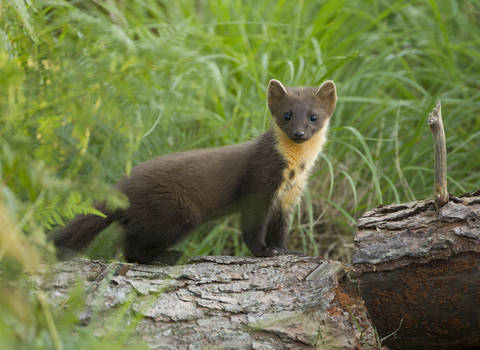Conservationists have discovered that pine martens, previously only thought to have survived largely in the North of England, are now well established in several areas of the New Forest and successfully breeding. The evidence was uncovered in the second year of a long-term study to understand how these rare and protected creatures are recolonising the area.
Pine martens, a cat-sized member of the weasel family, were once widespread across the UK. Habitat loss and persecution reduced their numbers, with only small and fragmented populations remaining, mostly in northern England, Scotland, and parts of Wales.
A growing number of confirmed New Forest sightings over the last six years led to the creation of a long-term study. Led by Forestry England and Wild New Forest, with support from Hampshire & Isle of Wight Wildlife Trust and a grant from the Love the Forest scheme, the project will map and monitor the growing New Forest pine marten population.
The team uses a range of techniques to study these nocturnal creatures, including hidden cameras. Over 100 video clips were captured in 2022, including some showing young pine martens exploring and playing together, providing further evidence that they are successfully breeding.
The new clips also confirm initial findings that pine martens prefer to use fallen trees and branches to navigate across the forest floor and to cross streams and wet areas.
During 2022, Hampshire and Isle of Wight Wildlife Trust has continued to support Forestry England, Wild New Forest and the New Forest Study Group, to determine the presence or absence of pine martens throughout the New Forest. Our staff have been monitoring one of the Wildlife Trusts’ reserves, using hidden wildlife camera traps, in an attempt to discover evidence that pine martens are using the woodland habitat.
Having reviewed over 10,500 trail camera clips since spring 2021 – equating to approximately 60 hours of footage – Trust staff were rewarded with five separate video clips of pine martens. This proved the area has suitable habitat to support these enigmatic and rare creatures.
Trust ecologist Jo Gore, who painstakingly reviewed many of those clips, said: “The opportunity to discover that pine martens are living successfully in the woods of the New Forest has been very rewarding.
“It has been a real pleasure to capture the secret life of the animals that use the woods. To see glimpses of pine marten and other rare species that use these protected areas has been very special.”

